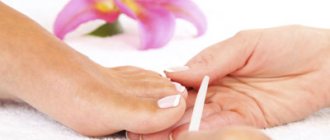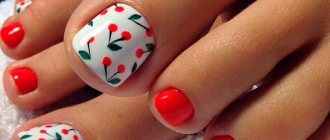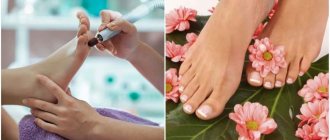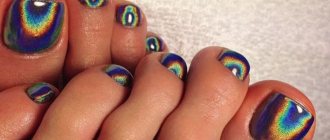A woman should always remain beautiful, from her hair to her toes. To keep your legs beautiful and well-groomed, you need to regularly get a classic pedicure. This is the most common method of treating nails and foot skin. During the process, existing calluses are removed, the rough layer of epithelium is removed, and the nails are tidied up. To obtain a positive result, it is important to comply with sanitary and hygienic standards and the technology of the procedure itself.
Increasingly, not only girls and women began to take care of the beauty and health of their legs. Men's classic, hardware and preparation pedicures are widespread in salons, especially during the holidays and hot seasons.
Features of the procedure
The pedicure procedure has features that largely depend on the condition of the feet, skin structure, etc. Regular foot care at home extends the period between salon visits.
The frequency is also affected by the rate of nail growth, since as the nail plate grows, pressure from shoes occurs, which can result in ingrowth into the skin. Complex and deformed nails can be partially or completely changed only in a salon setting using modern technologies by experienced specialists.
But you should not abuse the constant effect on the skin and nail plate. Frequent sanding and polishing can lead to cuts, large detachments, increased skin sensitivity and other unpleasant problems.
Classic pedicure technology step by step
Many women periodically do pedicures at home to keep their toenails beautiful and neat. Beauty experts believe that pedicures have a second benefit - they benefit your feet. Below is a step-by-step technology for performing a classic pedicure.
Our skin has three main layers. The upper stratum corneum has the ability to renew itself; this layer, by its structure, periodically gets rid of dead skin cells. And the soles of the feet are four times thicker than other parts of the body, so dead cells need to be cleaned frequently.
The skin of the feet is exposed to many factors, usually body pressure. Women wear shoes that are too narrow or have heels, which leads to foot deformities. Hardened skin ceases to be elastic, it cannot breathe and recover.
Therefore, cracks sometimes form between the toes and on the heels. To avoid these troubles, it is necessary to regularly perform pedicures and use various foot care products.
Classic pedicure lesson for beginners step by step
Pedicure is first and foremost a preventive procedure, then it is to give the feet an aesthetic appearance. Sometimes give your feet a holiday - prepare warm baths with sea salt and a few drops of essential oil. This procedure will soften the skin, relieve fatigue and stress on your legs. A similar bath is recommended 20 minutes before a pedicure.
Now let's move on directly to the step-by-step technology for performing a classic pedicure. Nails on your feet grow slower than on your hands, so there is no need to visit the salon often. However, you yourself can provide complete care for your feet:
- Before performing a classic pedicure, apply a rich cream around the nails and immerse your feet in warm water for a few minutes;
- Then use a nail file or scrub to remove the thick skin;
- Sea salt or abrasive cream promotes exfoliation;
- After which the cuticles should be treated with a wooden stick;
- After cutting the nails, the feet are covered with moisturizing cream;
- If your nails contain remaining old polish, remove it with a special product.
Nail varnishing is carried out as follows: sponges from a folded napkin are inserted between the fingers, then, starting with the nail of the little finger, we begin to apply varnish. The thumb is usually covered with three layers of varnish, the rest with two.
Classic pedicure at home - video tutorial
Pros and cons of technology
The advantage of a high-quality pedicure is to tidy up your feet and give them a well-groomed appearance. This is achieved by removing existing defects, decorating the nail plate with the most suitable method (device, edged, European) or a combination of types of pedicure.
Competent manipulations transform even the most problematic legs. After the session, corns, calluses, and ingrown nails disappear.
In difficult cases, a medical pedicure is useful, since a cosmetic pedicure only affects the aesthetic appearance of the foot. It is important to choose a professional master who follows all the rules of the procedure. Otherwise, a pedicure may lead to health problems.
Disadvantages of the procedure:
- if the instrument processing steps are not followed, infection can occur (including hepatitis and HIV);
- increased morbidity in the absence of experience;
- A trimmed pedicure activates the work of skin cells, which is why it grows quite quickly and becomes rough.
Stages of pedicure
The main stages of a pedicure include preparing the necessary tools, treating the surface of the feet, subsequent removal of skin defects, treating the nail plate (if necessary with a decorative coating), and moisturizing the skin with suitable cosmetics.
An additional condition is daily care, which allows you to prolong the result and keep your feet looking beautiful and tidy.
Carrying out a procedure in a beauty salon
Contacting a specialist will reduce the procedure time and get a better result. Some people wonder what it takes to get a pedicure at a salon. No preliminary preparation is required; it is enough to observe the minimum hygiene rules, and an experienced specialist will perform all the manipulations independently:
- Preparatory stage. A prerequisite before the procedure: the master’s hands are treated with an antiseptic and gloves are put on. Then the surface of the skin is disinfected to prevent infection. If there is a coating on the nails, it must be removed. For simple varnish, a special liquid is used; for gel, removal with a machine is preferable.
- Steaming the feet is required only in classical technology; the hardware method is performed on a dry surface. A bath of warm water softens the skin, after which the client’s feet are treated with a grater. This makes it easy to remove keratinized areas and carefully cut off the ridges around the nail plate and cuticle with pliers.
- In the European method, instead of steaming, professional pedicure products are used, which achieve a similar effect for treating calluses and removing corns. To soften the cuticle around the nail plate, a remover is applied.
- Nail treatment. Using a machine or tweezers, they are given the desired length and shape, and finished with a file and a grinder. If there are problem nails, a special tool is used to correct defects. To prevent ingrowth into the skin, you should not leave too sharp corners, but you should not round them too much.
- Nail coating. After treating the surface of the foot and correcting the nails, the process of decorative coating is carried out. This stage is carried out in accordance with technology. The first layer is applied with preparatory liquids (for degreasing and adhesion of the nail plate to the varnish), then a base layer (to protect the plate from the effects of dyes), after that several layers of colored coating (depending on density), and, if desired, decor/design , at the end - a finishing layer (to consolidate the result).
- Application of moisturizing and nourishing products. The procedure is considered complete if, after all manipulations, cosmetics are applied to the skin with massage movements. The active ingredients allow you to maintain the effect after the session for a longer period. To care for the cuticle, it is recommended to rub oil (almond, coconut, olive, peach and others).
https://www.youtube.com/watch?v=AI4-E6Jgyq8
Carrying out the procedure yourself
The inability to visit a salon is not a problem for home foot care. The sequence is practically no different from salon equipment. You must first prepare the instrument used and the skin of your feet. To do this, the feet are steamed in a bath or special exfoliating agents are applied.
After thorough steaming, rough spots can be easily removed using a grater or pumice stone. The overgrown cuticle is carefully pushed back with an orange stick and, if necessary, trimmed with nippers or nail scissors. It is important to follow the execution technology, as careless movement can cause injury and infection. The length and shape of the nail is adjusted.
At the end of the session, it is necessary to wash off any remaining cosmetic products from the surface and apply a nourishing cream.
Necessary tools and procedure steps
So, if you decide to carry out the procedure at home, then you need to prepare a set of tools and devices with which you will perform a trim pedicure. It includes:
- a bath of water to which you can add salt, herbs, and disinfectant;
- towel;
- manicure scissors;
- nail polish remover;
- orange sticks, cuticle tweezers;
- cuticle softener;
- nailfile;
- pumice for feet, scrapers, special files for feet;
- moisturizing cream.
You should consider trim pedicure and its technology step by step, as well as its main differences from the European version. As already mentioned, you can do it at home.
- First you need to steam the skin of your feet. To do this, you can use either regular warm water or with additives, for example, sea salt or chamomile. The optimal water temperature is 38°C-40°C. Keep your feet in the bath for about 10 minutes, this time will be enough for the skin to become soft. Now you need to gently dry your feet with a towel.
- After this, you need to wipe off any remaining polish from your nails, if any. This can be done before steaming; this point is not important, but the softened varnish will be easier to remove. Next, you should trim the nails, giving them the desired shape. There is no need to round them too much to avoid ingrowth.
- You can apply additional skin softening agent. This stage is not mandatory, but may be required if the dermis is too rough and there are a large number of growths on it.
- Then we proceed to remove the stratum corneum from the heels and toes: using a pumice stone or a special file, you need to carefully remove the dead skin, smoothly moving from the center of the area to its edge. You can periodically wipe your feet with a damp towel so that excess skin does not interfere with manipulation.
- A few words need to be said about how to properly treat the skin around the nail. The cuticle can be further softened using a special product, and then pushed back with an orange stick. After this, tweezers are used to remove excess skin. It is at this point that a trimmed pedicure is fundamentally different from a European one, which only requires pushing back, but not cutting, the cuticle.
It is worth cutting very carefully. There is no need to rush, as only smooth movements will avoid cuts. It should be noted that cuticles that are not trimmed grow more slowly and become softer over time. However, it will take several treatments to get it looking good. A trimmed pedicure allows you to achieve instant results, but you will have to carry out this procedure more often.
6.Now you can file your nails and polish their surface. This should be done only when the feet are completely dry, so as not to injure the nail plate. Apply cuticle oil and moisturizer to the heels and perform a light massage.
Thus, we can say that doing a classic pedicure at home is not at all difficult. The most important thing is to approach the procedure seriously and not rush. You must adhere to all stages and perform them correctly, in accordance with all recommendations. Regular foot care will allow you to wear any shoes without embarrassment and show off your bare feet on the beach.
Actions for sore fingers
In some cases, finger inflammation occurs after a pedicure. Unpleasant symptoms appear the very next day. This is due to the fact that an injury was sustained during the procedure, although it may not be immediately noticeable. The skin of the thumb is most often affected.
To prevent the infection from spreading to other areas, do not wait for swelling and accumulation of pus. It is recommended to consult a specialist who will examine the finger and prescribe appropriate treatment. This is a course of antibiotics, applying bandages with antibacterial agents, using a medicinal foot bath, taking vitamins to increase immunity.
At home, they effectively relieve inflammation and draw out purulent contents using a bandage with aloe, honey, potatoes, and celandine. Starting treatment from the first days will allow you to quickly cope with the problem without subsequent contact with a surgeon.
How often to care for your feet
There is no clear answer to how often you can get a pedicure. The frequency of the procedure is influenced by multiple factors. This includes the time of year, a person’s lifestyle, preferred shoes, structural features of the skin, and health status.
Daily care is also important, which prolongs a salon or home pedicure - how often it needs to be done depends on the appearance of the legs. Rapid growth of the cuticle and roughening of skin areas requires more frequent procedures. But when using various cosmetic products for foot care, a visit to a good pedicurist is required much less often.
To nourish and moisturize dead skin, apply a drop of oil and rub in thoroughly with massage movements.
The question of how often to get a pedicure is also influenced by the technique you choose. With trimming technology, the coarsened layers are cut off, as a result of which the cells begin to actively grow, which leads to the rapid coarsening of areas. An alternative is to choose a drug or hardware pedicure.
With proper care and normal condition of the feet, visits to manicure and pedicure studios are carried out once every 3-4 weeks. If you have problem nails and other features of the skin of the feet, it is recommended to carry out the procedure after 1-2 weeks. A quality pedicure is an integral part of your look.
What is a pedicure and how does it happen?
The word "pedicure" comes from the French combination of "foot" and "care", which in practice means caring for your feet - removing dead skin, polishing and painting nails, cleaning and moisturizing your heels. You need to do this about once every week and a half, thus ensuring your legs have a healthy and well-groomed appearance, and your skin has good tone and moisture. In addition, regular pedicures help prevent the formation of corns, cracks, calluses, and fungal diseases.
There are several types of foot care:
- Classic trim pedicure is the most popular method. To soften the feet, keep them in warm water for some time, then use special tools to remove excess skin, cut off and shape the nails. This is also one of the most effective methods at home. Its disadvantage is that if you are careless and do not maintain hygiene, you can get hurt or get an infection.
- Unedged “dry” pedicure differs from the previous one in the method of combating the cuticle. Here they do not cut it off, but apply a special gel that softens the delicate skin. Then it is simply moved to the base of the nail. The more such procedures, the weaker and thinner the cuticle becomes. The disadvantage of this method is that it cannot be used to tidy up rough skin or remove calluses and corns.
- Hardware pedicure – foot care using a special machine with attachments. The method is low-traumatic and practically safe in terms of transmission of infections, but it also has its drawbacks: for a hardware pedicure at home, you need to have the appropriate equipment and skills.
- Acid pedicure – removal of rough skin using special fruit acids. The advantages of the method are efficiency, long-lasting results, and absence of discomfort during the procedure. The disadvantages are the likelihood of drying out the skin of the feet, the possibility of allergic reactions, and the high cost of such a special solution for pedicure.
Interesting! In past centuries, pedicures and manicures were performed by barbers. Special salons for hand and foot care appeared in Europe only at the beginning of the 20th century.











